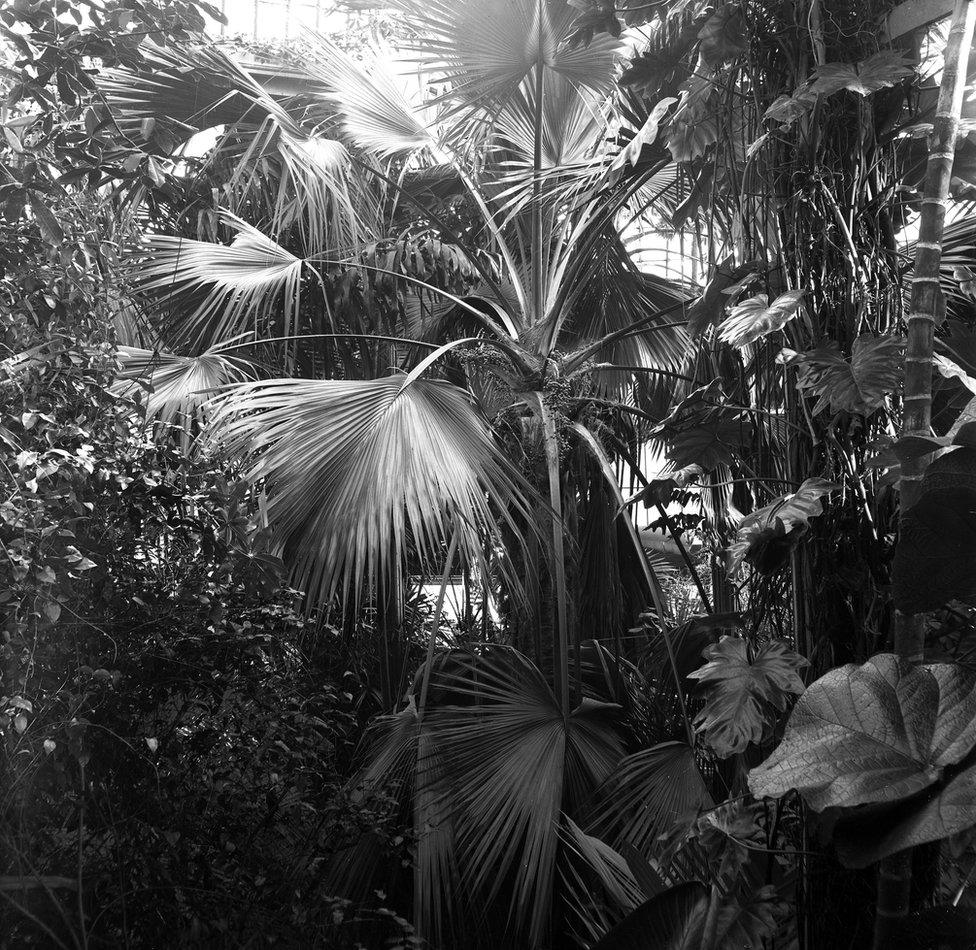200-year-old palm comes down in Edinburgh Botanics renovations
- Published

Simon Allan, who has cared for the palm for a decade, said he was emotional about losing it
A Scottish horticulturist looking after a palm tree, growing for more than two centuries, says he can't bear to watch it being chopped down to make way for hot house renovations.
Simon Allan has been caring for the Sabal palm at the Royal Botanic Garden in Edinburgh for a decade.
More than 40,000 plants are being decanted from glasshouses as part of a multi-million pound upgrade.
The palm is too large to be removed in one piece and will be felled next week.
Experts at the botanic garden said the Bermudian fan palm, Sabal Bermudana, was near the end of its life.
Mr Allan told BBC Scotland he's glad he will be on holiday when it is cut down.
He said: "I have been looking after it for 10 years, looking up at it and wondering if it's alright, giving it a drink and feeding it. When a plant is looking good you know that it is happy.
"It gets watered every day, liquid feeds that are seaweed based regularly and topped up with fresh compost annually."

Simon says goodbye to the Sabal palm
The 60ft (18 metre) palm is the oldest known plant in the Royal Botanic Garden Edinburgh.
It is understood to have been transported nearly 4,000 miles from Bermuda to Germany before being shipped to the Port of Leith in 1810.
It was planted off Leith Walk, where the Royal Botanic Garden Edinburgh had a site at the time, and then 12 years later it was moved to the current site at Inverleith, where it has been ever since.
The palm has been getting shaved for the last decade, which causes it to lose vigour, as it has been threatening to burst through the glass canopy at the hot house.
Mr Allan said: "It could live for another 20 to 30 years. It's so sad. But it's in decline, it's geriatric age, and although we have nothing with more historical and sentimental value, the unique setting of the building means we have to carry out these repair works.
"For its age it's looking great but it's not what it once was.
"It's an opportunity to start afresh and we have hundreds of its offspring as seedlings, which we are cultivating."
In the wild, a Sabal palm could live up to 200 years growing in a sheltered place, however hurricanes often fell them before then.

James McNab who looked after the Sabal palm in 1874
The renovation works mean the glass panels have to be removed and the palm could not be kept in the tropical conditions it needs to thrive.
The palm, which weighs eight tonnes as it holds so much water, will be chopped down in sections on Tuesday.
The palm has not always been such an imposing sight.
James McNab who was the supervisor of Sabal in 1874 said in an Edinburgh Journal of Botany that it sat on the ground as a lump for 40 years before it started to grow a trunk.
It then took 80 years before it flowered for the first time. It self pollinates as it has both male and female flowers and the opening and closing of doors in the palm house is enough passage of air for this to happen.
Back then it was in what was called the Stove House. Coal fired boilers fuelled by stokers kept the heat up for the tropical plants. Then in 1858, a new Tropical Palm House was built for it.

How the Sabal palm looked some time between 1902 and 1906
It is thought it was transported to Scotland in a Wardian case, which was a small portable green house which protected it from the salty spray on the boat and kept it in the humidity it needed.
'Securing our future'
When it comes down, some of the wood from its trunk will be used for education and the rest will be used by artists in residence at the Botanics Karine Polwart and Pippa Murphy.
A triptych will also be painted by botanical artists Jacqui Pestell and Isik Guner.
Tropical botanist Dr Axel Dalberg Poulsen will take parts of all the key elements of the palm (seeds, leaves, bark etc) to preserve as a Herbarium specimen for research.
The palm houses will be stripped back to their core stone and iron work, repainted and refaced.
All the metal work will be repaired and window panes reglazed, with more thermal efficient glass.
The Biomes Project, which will be complete by 2027, has been described as the most significant project in the garden's 350 year history.
Fiona Inches, glasshouse supervisor for the Edinburgh Biomes Initiative, said the work was vital because the current condition of the buildings meant the plants were vulnerable.
She said: "With extreme weather that we are getting - be it from high winds or extreme cold where we get constant burst and frozen pipes - we lose glass.
"The drips with the rain coming through on the collection as it is, is an issue. We do get that water ingress into our collections which means the plants are sitting wetter than they should be.
"We can't dry out the arid collection particularly well over the winter because the house is wetter than we would want."
She said the renovation project was "really securing our future for the next 200 years."